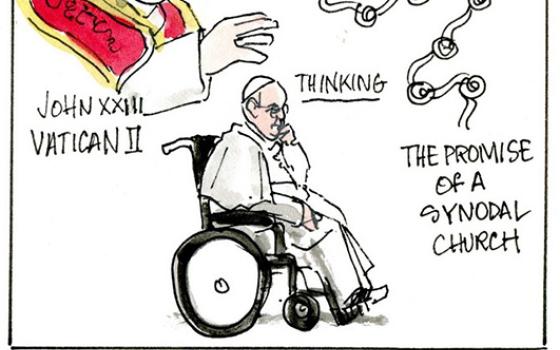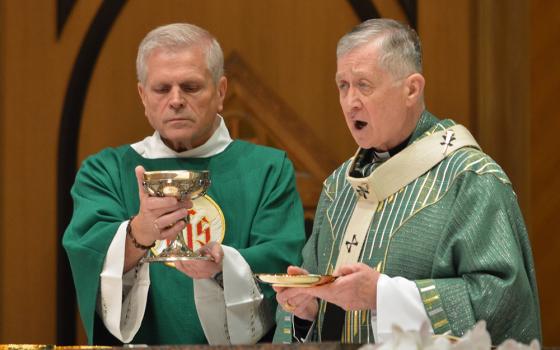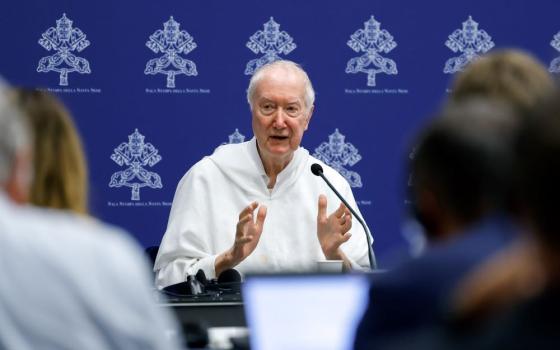
(Dreamstime/Aaron Amat)
I have been struck by social media comments from several progressive Catholic women who criticized Pope Francis' decision to extend voting privileges to laypeople, including women, at the 2021-24 synod on synodality.
One European woman wrote she could not celebrate synod votes for women, even though many others were. As she sees it, the Vatican is only throwing a meager bone to Catholics eager for women's equality in the church.
In addition to the estimated 300 bishops who will attend October's synod, Francis will select 70 nonbishop members from a list of 140 names submitted by seven international groupings of bishops. Francis has asked that 50% of these be women, and that candidates include young people.
Another five women and five men religious will represent institutes of consecrated life, bringing the total number of female members to at least 40. (I say at least because Francis will also appoint voting members himself, some of whom may be women.)
My European acquaintance — apparently working from the win-lose template decried by some — lamented that since synod decisions require a two-thirds majority and nonbishops constitute only 22% of those eligible to vote, the laity would not be able to block any votes next October.
A female activist from the U.S., while happy about this new opportunity for women, believes it all but certain that female delegates will be handpicked to not rock the boat.
Do I believe that adding a female lens to a patriarchal system can make a difference? That would be a resounding yes.
Given the Vatican's history of discounting women's voices, from oral contraception to ordination, it is hardly surprising that Catholic women feel somewhat cynical. While I have my own cynical moments, Francis' expansion of who may exercise deliberative voice and vote at the synod represents significant progress.
I have found that anytime a female lens is added to the equation, something new can happen. Plus, I anticipate more than a few "handpicked" Catholic women will broaden the vistas of synodal deliberations and decisions.
Here are a few examples from my own experience.
Three years after co-founding FutureChurch in 1990, I completed a theology degree at our local seminary and was certified as a pastoral minister. After the Vatican essentially forbade further discussion of women's equality in church ministry and decision-making by publishing Ordinatio Sacerdotalis and Responsum Ad Dubium, a number of us, including the director of the pastoral ministry office, began to meet privately for networking and support.
I became well-acquainted with the views of many female pastoral ministers and parish administrators who found it unhelpful (at best) to silence the conversation about women's equality in the church.
There are many women working within institutional Catholicism who, given the opportunity, will find appropriate ways to advocate for needed change.
Before beginning to work in church renewal and reform, I was one of many nurse midwives who helped catalyze change in another patriarchal system — obstetrics and gynecology.
Advertisement
Midwives are trained to support the energies of the woman herself in labor and birthing. In the 1970s-'80s, the prevailing obstetric culture seemed to be that birth was something done to a woman rather than something she herself did.
During one clinical training rotation at a Tennessee hospital, I saw women routinely being strapped to the delivery table and given anesthesia so doctors could use forceps for the birth. As midwives, we hated this practice. We knew we had a long way to go if we were to change the culture.
When I moved to Cleveland several years later, there were only about eight midwives in the entire city. Five of us practiced at an excellent county hospital that also trained OB-GYN interns and residents. We worked hard to promote women's birthing autonomy and stood firm in minimizing unnecessary interventions (such as routine episiotomies or forceps) in normal birthing.
Our efforts bore fruit. We were helped by an influx of women seeking residencies in OB-GYN. They brought a female lens to the prevalent interventionist OB-GYN culture. They became our staunchest allies and embraced our birthing model with a vengeance.
A new standard of care emerged. This one emphasized the right of each woman and her partner to develop their own birth plan for providers to follow, insofar as safety allowed.
Nationally and locally, midwives opened free-standing birthing centers that attracted hundreds of women determined to preserve their own power during this most sacred of moments. Soon, hospitals were pretty much forced to open their own birthing centers.
A formerly patriarchal birthing culture was being transformed. While there is room for improvement, no one today would ever consider strapping a woman down to give birth.
So, do I believe that adding a female lens to a patriarchal system can make a difference? That would be a resounding yes.
Bear with me as I share one final experience, this one more directly related to synods.
Change doesn't happen because of a two-thirds favorable vote. A two-thirds vote only ratifies a change that has already occurred.
Prior to the 2008 Synod on the Word of God in the Life and the Mission of the Church, FutureChurch supporters sent nearly 20,000 paper and electronic postcards to church leaders and synod delegates asking them to invite women biblical experts and restore biblical women deleted from the lectionary. (No women theologians had been included in the 2005 synod on the Eucharist.)
Packets of materials containing lists of women biblical scholars and extensive documentation of the "Amnesia in the Lectionary" about deleted biblical women were also sent to 25 English-speaking bishop delegates.
We were delighted that 25 women were invited to participate in the 2008 synod. Up until that time, it was the most women to ever attend a Catholic synod. Six female experts and 19 female auditors brought a female lens to this historic gathering that universally affirmed Dei Verbum, the Vatican II document on the Bible.
Our packet of lectionary information seeded synodal discussion of women deleted from the readings at Mass. For the first time in history, bishops discussed the need to restore women's stories. Judging from the responses I received from many prelates, most had no idea that biblical women leaders had been sliced out of lectionary texts. They were embarrassed.
Two final synod propositions praised "women in the ministry of the Word" and asked to open study of the lectionary with a view to updating lectionary texts.
I share all of the above as examples of how incorporating a female lens can bring new information to church deliberations and begin to catalyze necessary change.
Change doesn't happen because of a two-thirds favorable vote. A two-thirds vote only ratifies a change that has already occurred. Change begins when something — often a small something — catalyzes the larger body and moves it to consensus. Jesus' example of the kingdom of heaven being like the woman adding yeast to leaven the flour comes to mind (Matthew 13:33).
I'm betting that more than a little leaven will be found among the synod's 22% of lay voices.








